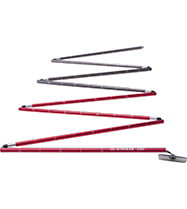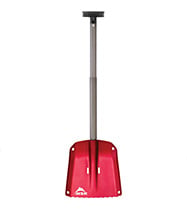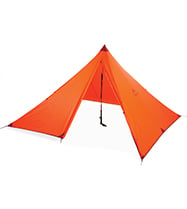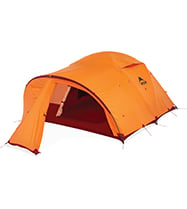Assessing Avalanche Danger: Backcountry Touring & Snowmobiling
Jackson Hole, WY, the place I’m lucky to call home, has gained an international reputation for three things: skiing, powder and skiing. It’s the lifeblood of our 15,000-person town, based in the northeast corner of the least populated state in the country. The most accessible backcountry terrain, Teton Pass, sees just shy of a quarter-million runs each year, more than many small resorts. The obvious and very real downside of so much backcountry use is that the avalanche danger is high, and you and your party are often not the ones who trigger it.
To get further away from the crowds I banded together with four of my closest friends, rented three snowmobiles and planned a three-day, two-night winter camping and backcountry skiing trip to a lesser traveled zone an hour north of town. For the sake of keeping this place the way it is, I’ll refrain from using its name and keep some of our travel logistics vague. Instead of giving you a play-by-play, I’ll provide a sense of why we went to these lengths and the tools you’ll need to replicate a similar journey.
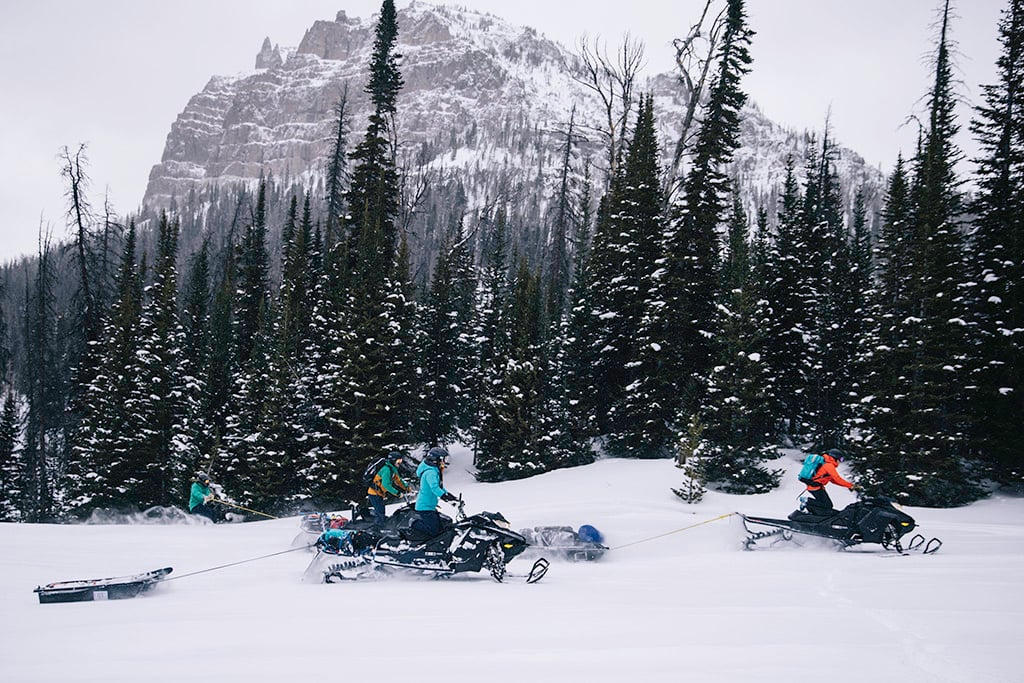
Plan a Route
With the right group assembled, our next step was to plan a route. Using the Gaia GPS map and suggestions from friends, we sketched a handful of options onto maps, each about 10 miles from the trailhead. We would use well-trafficked snowmobile trails to get into the range, then break our own trail to a remote bowl and set up a winter basecamp. To bring extra warm layers, surplus food, ski gear and enough beer, we borrowed plastic polks (essentially big burly sleds) to tow behind the snowmobiles and serve as porters.
Plan for the Cold
Though our entire group had ample backcountry skiing experience and Level 2 avalanche certifications, only two of us had winter camped before, so we spent the majority of our planning time on discussions around the right tents, stoves and gear to bring. We also gave ourselves extra time on the trip to teach and learn new skills, help keep each other dry and warm, and enjoy the entire experience, rather than rushing to set up camp and risk one or more folks having a bad time. This meant we would take care to find the right campsite, dig out a great pad for the cook tent, and chop enough firewood for warm evenings together.
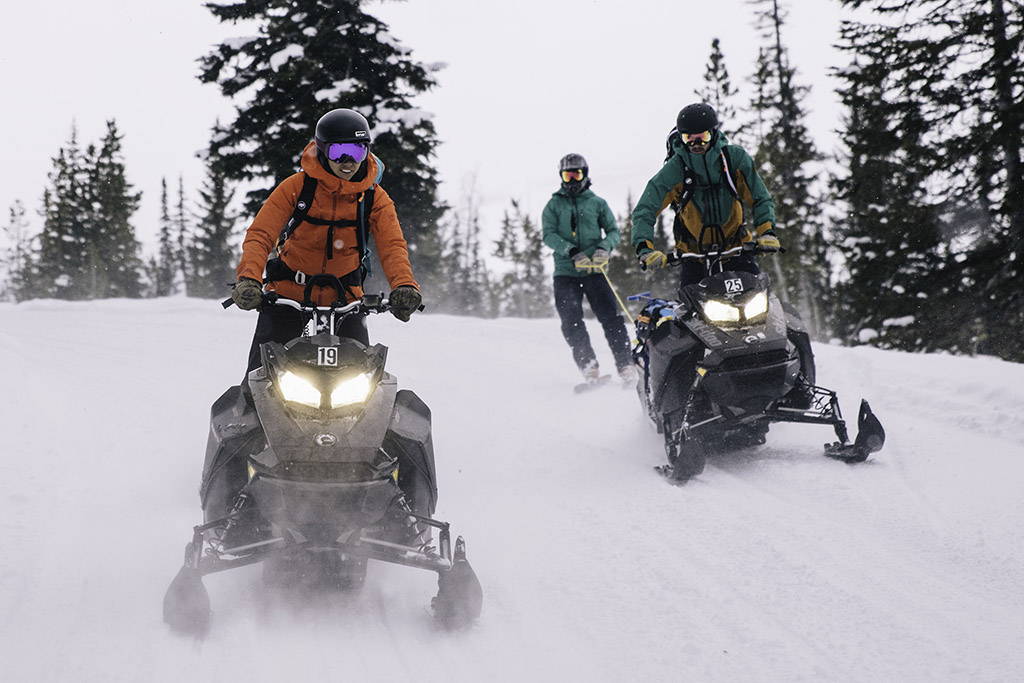
Setting Out
We rendezvoused at 6:30 a.m. on the day of departure and drove north in a caravan after briefly running through the essentials—skis, skins, boots, poles, avalanche safety gear, spare socks and gloves, warm sleeping bags, puffies and negative COVID tests. Comfortable we had packed correctly and mitigated risk as best we could we set off, driving slowly into a blossoming snowstorm.
At the parking lot, there were only two other trucks with trailers, a sign that we would likely find the solitude we were looking for. Snow was still falling and shortly before leaving cell service, we checked the avalanche report, a habit that everyone who travels in the backcountry during the winter should make. This mountain range is notably different from our backyard terrain, the Tetons. Here we were entering a Continental snowpack, which is often more faceted, shallow and temperamental. We knew we had to be extra careful and come at this trip with fresh eyes.
By 10 a.m. we were fully loaded—duffels full of food, camp gear and supplies were tied down to the sleds, and all three snowmobiles were loaded and ready to go. Pulling out of the parking lot, I couldn’t help but be excited to put my phone into airplane mode for a few days and just enjoy our trip into the backcountry. The first handful of miles took no time at all, a small and gradual climb to a large and popular snowmobile basin. From there we took a ninety-degree turn and headed east, breaking trail through four or five inches of light powder.
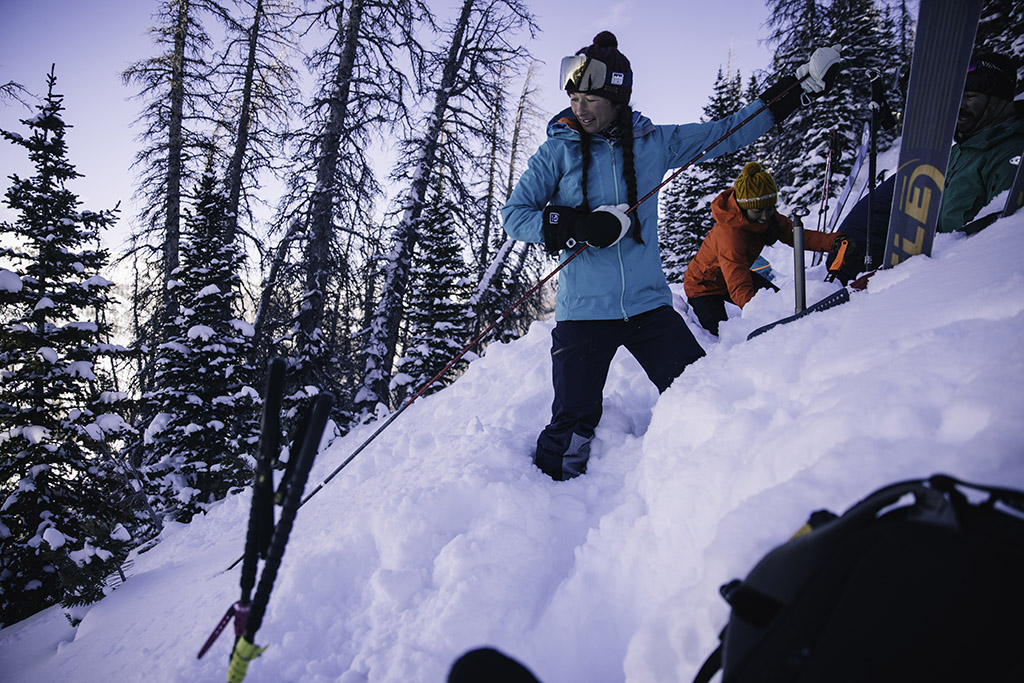
Recognizing Avalanche Dangers
From here on out we were in avalanche terrain, crossing a few known slide paths on the snowmobiles into basecamp and later touring in a bowl with 30- to 40-degree slopes, which is the prime range for sliding. The avalanche considerations for skiing and snowmobiling are similar, although not identical. Snowmobiles, with their weight and power, are much more likely to trigger deep persistent slabs. Skiing, where you’re generally on steeper, more technical terrain, has a higher likelihood of triggering storm slabs, wind-loaded slopes, and big sluffs. All of these risks were present on our trip, so we needed to be vigilant whenever we were crossing, ascending, or dropping into terrain with slide potential.
Stopping every mile or two to check the maps, we steadily made our way towards the chosen bowl. The last mile was the most challenging, with a series of tight trees to navigate and sidehilling (riding a snowmobile on one edge across a slope) that was challenging with our heavy loads. After getting the snowmobiles stuck a few times and working together to dig them out, we finally found a small meadow that fit all our needs– it was close enough to the area we wanted to ski, away from avalanche paths, and had a nice, natural wind block. Parking the snowmobiles, we began setting up camp.
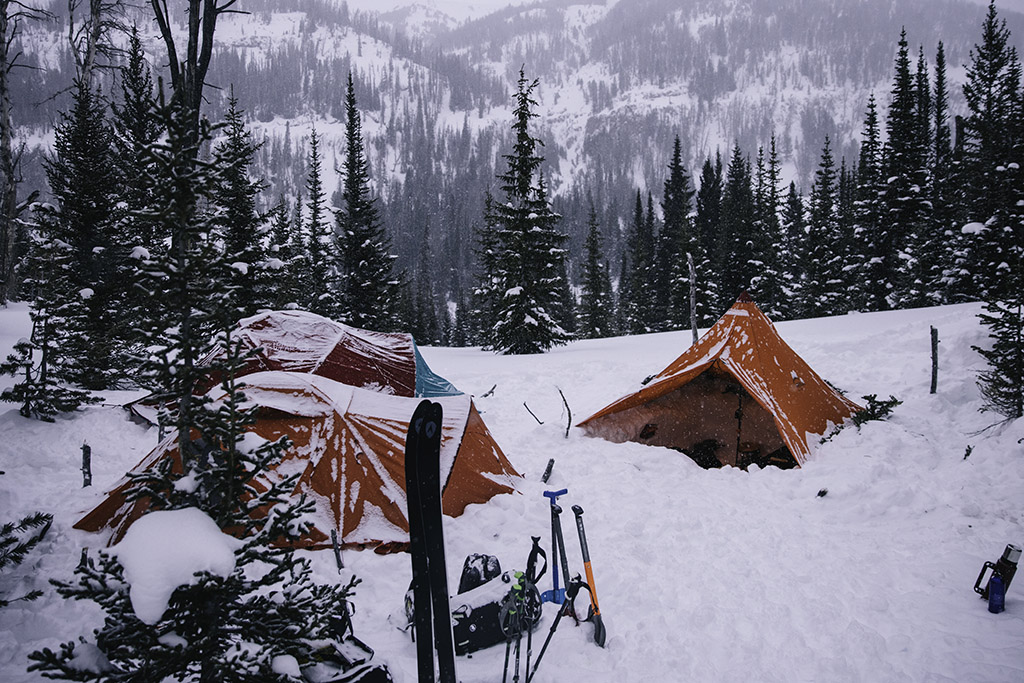
Setting Up Camp
Step one was building a platform, which we did by all clicking into our skis and stomping down the snow as best we could. This gave us our first good look at the snowpack and some of the possible hazards for the next few days. A foot below the recent storm snow was a moderately thick crust and below that an incredibly faceted, sugary layer. This posed challenges for building camp—it was nearly impossible to build wind walls because it was so loose, and even harder to dig out an even shape because the walls were barely capable of supporting themselves.
Making due, we decided to set up our two sleeping tents on the snow’s surface near a thicket of trees that would serve as a wind block. The cook tent wouldn’t have the typical cooking platform or benches due to the looseness of the snow. Instead, we dug nearly to the ground and supported three of the walls with spruce branches to give the snow a bit more strength and integrity. All in all, this took a couple of hours and by the time we had all three tents set up, sleeping gear organized and inside, wood chopped for an evening fire and a late lunch in our bellies, we were pretty hungry to ski.
Fortunately, the terrain near our campsite was prime for some afternoon turns. With moderate temps and thick cloud cover, we weren’t worried about wet slides at all. Skinning up the valley on a west-facing rib, we wandered the track back and forth around trees, plotting our descent back to camp. Just over a thousand feet up we broke tree line and decided to transition, hoping for some time in camp before dark. Despite a shallower snowpack than the Tetons, these low-angle turns were fun and filled us with yelps of joy.
Back in camp, after putting on dry layers and extra puffy jackets we got to work melting snow and boiling water, preparing our Good-to-Go dehydrated meals and lighting the fire. The group was starting to mesh, requiring less talk to quickly get these simple chores done and arrive at the more enjoyable part of the night, toasting and sharing stories around the campfire.
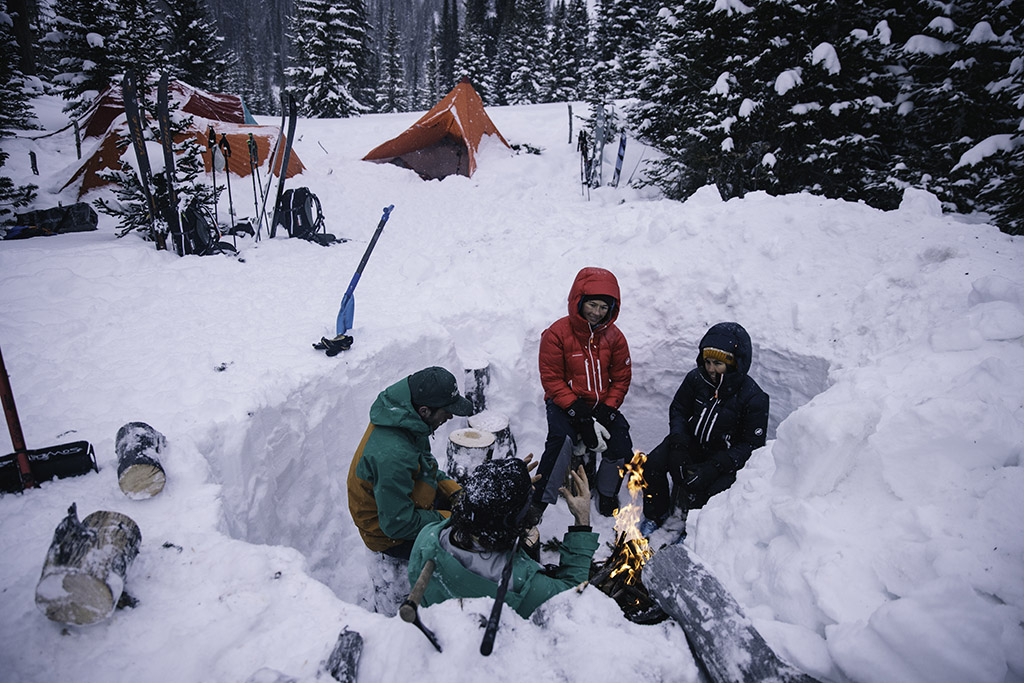
Keeping Warm
After 11 hours of sleep, we woke well rested and surprisingly warm—our zero-degree bags, thick sleeping pads and four-season tents had trapped enough heat that we didn’t recognize the outside temps were well below zero. Crawling out of bed I realized that making water for coffee would be a larger challenge than normal, fighting to keep my fingers and toes warm while our MSR Reactor stoves melted snow and produced enough hot water for five meals and hot drinks.
Throwing on our ski gear, we knew that the sooner we started moving, the sooner we would warm up our extremities. We still took the time to do a beacon check and made sure everyone had avalanche essentials, extra food, water and layers before heading out for the day. Moving up the valley into the main bowl, the weather was foul—24 hours into the trip and snow was still falling. This meant two things: we would need to dig a pit to assess the snowpack and, most likely, the skiing would be excellent.
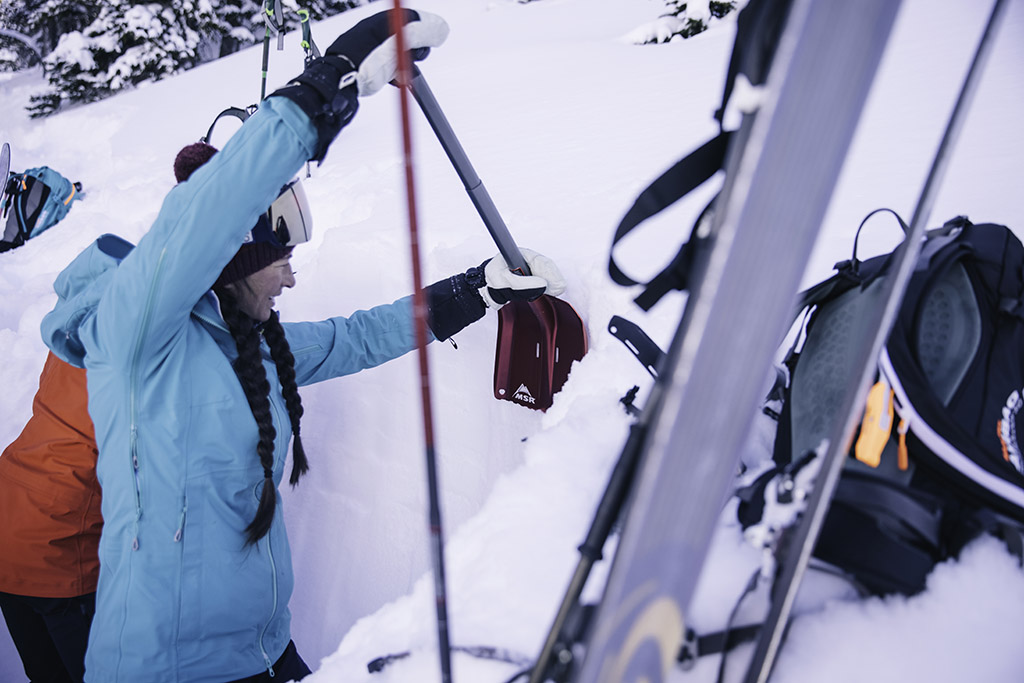
Assessing Avalanche Dangers for Backcountry Skiing
Partway up the slope on an aspect that we all wanted to ski, we stopped to dig a snow pit and do some column testing. Curious to see if the new storm snow was bonding to the crust below it, we ran through procedures learned in avalanche classes and refined through hundreds of hours of backcountry touring. Because it was north-facing, the snowpack here had a much smaller crust and was a bit deeper, likely from wind transporting snow from the top of the ridge downwards. The big risk was a deep, persistent, weak layer that was so faceted it wouldn’t stick to anything—just pure sugary snow. If we put enough force into a turn or got unlucky at a trigger point, we might create a massive slide.
Noting this, we continued upward, working our way into the alpine and topping out just below a cliff band that needed a lot more snow before it was safely skiable. With the lower slopes more filled in, we leap-frogged down between islands of safety, avoiding any major terrain traps. After three long laps to the valley floor and back up to the transition spot, we returned to camp, pleased to have triggered nothing more than a few sluffs on small convexities. Tired and happy, we got to work right away starting a fire and heating snow for water.
Although we had heard a few snowmobiles in the distance, we hadn’t seen another person which was a treat for us. On the second night, we dug a pit around the fire to reflect heat and brought some stumps inside the makeshift ‘air jacuzzi’ for a surprisingly comfortable hangout. The later it got, the more philosophical and weird the conversation grew. Around 10 p.m. the storm finally started to break, giving us our first glimpse of stars above and signaling bedtime for me.
On Sunday, our last day, we agreed to pack up camp first then ski for a half-day before loading up all the gear and snowmobiling back to the trucks. We climbed a new ridge all the way to the summit pinnacle and stopped just short of a small family of bighorn sheep. After watching them for a bit, we transitioned and carefully skied down the wind-swept face before digging another pit in an area with snow that was more representative of our descent. After agreeing the snowpack here was more bonded than the zone the previous day, the group dropped in.
Just a few hours later we were back at the trailhead, the sun shining and each of us brimming with happiness from a great weekend in the woods. Using a mixture of patience, wit, the right tools and learned risk-assessment, we successfully avoided the avalanche-prone slopes and still found great turns each day. I can’t wait to do it again.
Before heading out on your own backcountry trip, there are a number of important considerations. First, make sure you and your group read the local avalanche report, are familiar with avalanche safety and rescue techniques, and know how to read and assess risks in the snowpack. These skills are critical and a lifelong learning process. Taking one avy class is just the start of that process—every time you go into the backcountry you learn more and refine the skills you already have. It’s also important to have the right tools, like a beacon, shovel, probe, snow saw and radios for everyone in the group. These tools help you understand the snowpack better, stay safer (although they don’t guarantee anything), and let you communicate better with the entire group. I never tour with someone who doesn’t know how to use these tools, because it puts both of our lives at risk. Finally, keep communication constant and ensure the entire group is comfortable and in agreement. You’re out there to have fun after all!
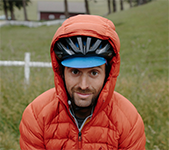 Andy Cochrane
Andy Cochrane
As the son of two park rangers, Andy built a lot of forts as a kid. He went on to get an MBA and work at software giant Autodesk, then hit a mid-twenties-life crisis that led to five years of living in his Toyota Tacoma. He now resides in Jackson, WY, with his dog Bea and works as a freelance producer, writer and photographer.
Related Posts:
- Backcountry Basics: How to Use Your Beacon, Probe & Shovel
- Avalanche Safety: What Every Snowshoer Needs to Know
- Backcountry Basics: How to Use Your Beacon, Probe & Shovel
Updated. Originally Published February 23, 2022.

